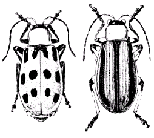Reports on Plant Diseases |
|
RPD No. 905 - Bacterial Wilt of Cucumber and Muskmelon
|
October
1999 |
[ Symptoms
] [ Disease Cycle ] [ Control
]
|
Bacterial wilt, caused by the bacterium Erwinia tracheiphila,
is a common and destructive disease of cucurbits. The disease is most
common on cucumber and muskmelon (cantaloupe), but less damaging to
squashes and pumpkins. Watermelons are apparently not affected by it.
Losses from bacterial wilt vary from the premature death of occasional
plants to as high as 75 percent of a crop. |

Figure 1.
Bacterial wilt on cucumber vine. |
| 
Figure 2.
Bacterial wilt on muskmelon |
Symptoms
Expression of the disease symptoms varies with different
crop species. On cucumber and melon, bacterial wilt first appears
on leaves as dull green patches that rapidly increase in size. Within
a day or two the wilting symptoms spread to leaves up and down the
runner (Figure 1). In a short time these and later affected leaves
on the runner turn brown, wither, and die. The bacteria spread from
the infected runner to the main stem and then to other runners. The
entire plant soon wilts, shrivels, and dies. Less susceptible plants,
such as squashes and pumpkins, may show a dwarfing of the vines, sometimes
accompanied by excessive blossoming and branching.
If a severely affected stem is cut across at the
base and squeezed, a creamy white bacterial ooze may exude from the
cut vascular tissue. After a minute or two the droplets will adhere
to a finger or knife blade and may be slowly pulled out into delicate,
shiny threads about l/4 inch long. This test is helpful in diagnosis
of the disease. The test works well for cucumber, but poorly for muskmelons.
Bacterial wilt is easily confused with other causes of wilting, including
Fusarium or Verticillium wilts, root or stem rots, gummy stem blight,
nematode damage, an excess or deficiency of moisture, damage by root
or stem feeding insects, or an excess of fertilizer.
|
| Disease Cycle
The bacteria overwinter in the digestive tracts of
hibernating, adult striped and spotted cucumber beetles (Figure 3).
In the spring the bacteria are introduced into the leaves of cucurbits
by the beetles as they feed. The bacteria enter cucurbit tissue only
through wounds, such as those produced by beetle feeding. When the beetles
are absent, bacterial wilt does not occur. The pathogen is not seed-transmitted
and does not survive in soil.
Weather conditions have an indirect effect on the disease,
in that environmental conditions which favor the overwintering, feeding,
and reproduction of the cucumber beetles subsequently affect the prevalence
of bacterial wilt. A good winter snow cover followed by warm temperatures
in March and April can be expected to increase the number of overwintering
beetles and therefore increase the early incidence of
bacterial wilt.
When a beetle feeds on a diseased leaf, its mouth parts
become contaminated. The wilt bacteria are then introduced into the
next several plants on which the beetle feeds. Beetles remain infectious
for at least three weeks. Infection of cucurbit plants occur only when
sufficient water from dew, rain, or irrigation is present to allow the
bacteria to penetrate the inner leaf tissue via feeding wounds. Wilting
may be visible in several days, and the entire plant is invaded in l2
to l5 days. Field symptoms are usually apparent approximately one month
after the beetles appear.
Bacterial wilt develops when daily temperatures average
between 46 and 72 F (7 to 22 C) with an optimum of 52 to 60 F (ll to
15 C). The bacterium grows best at temperatures of 77 to 86 F (25 to
30 C), and under conditions of high relative humidity. Bacterial isolates
differ in their virulence on each species of cucurbit. Some isolates
that are highly virulent on cucumbers are also quite virulent on squashes
while others that are less virulent on cucumbers usually are not virulent
on squashes. However, distinct cucumber and squash strains of the bacterium
may exist.
Back to Top |

Figure 3.
Cucumber beetles. Left, spotted; right, striped (USDA photo).
|
Control
1. Provide season-long control of spotted and striped cucumber
beetles and other insects, such as grasshoppers and squash bugs, with insecticides.
Start applications as the plants start to crack the soil, before the leaves
appear, even if no beetles are evident. Frequent applications are necessary,
especially in the seedling stage, to keep the foliage free of beetle-feeding
wounds. Applications may be needed at 4 to 5 day intervals. Repeat after rains,
especially if beetles are present. Early-season sprays or dusts are the most
important step in controlling bacterial wilt. Make treatment in late afternoon
or evening to avoid damage to bees. The use of a systemic, soil-applied insecticide
will provide moderate control for 5 to 6 weeks. Supplemental foliar insecticide
treatments, however, will be necessary. For current insect-control recommendations,
read University of Illinois Extension Circular 1354, Illinois Homeowners' Guide
to Pest Management (revised annually).
2. Plants in the home garden can be protected against insects
by starting them under Hotkaps and then enclosing them in cheesecloth tents
for several weeks until blossoms appear. Apply a recommended insecticide frequently
after removing the covering. Follow suggestions of University of Illinois Extension
Entomologists and your nearest Extension adviser.
3. In small plantings, pull the wilted plants at the first
sign of disease and destroy them after first spraying thoroughly or dusting
with a suggested insecticide.
4. Where feasible, grow adapted, partially resistant cucumber
varieties. For information on currently recommended varieties, read the Illinois
Homeowners' Guide to Pest Management, Circular 1354, which is revised annually
and available at the Information Technology and Communication Services at the
University of Illinois.
Back to Top
|



